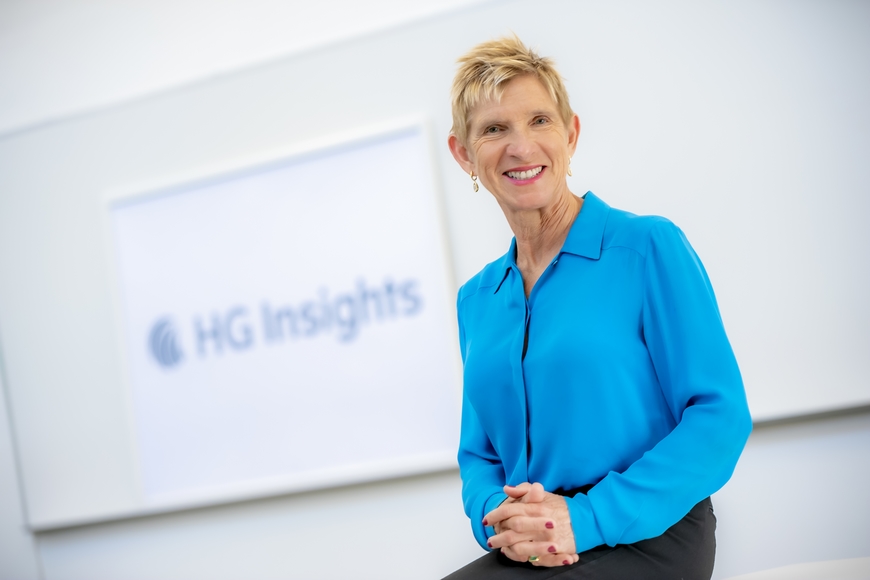Data and Discovery
How do you defend things that seem opinion based? The answer is pretty straightforward, says alumna Elizabeth Cholawsky (PhD ‘83, political science), “you get the data on it.” It’s advice that has served her well—from her first job with the CIA to serving as CEO of software company HG Insights, Cholawsky’s passion for data and discovery has guided her every step of the way.
Tell us how you landed at the University of Minnesota? What drew you specifically to political science?
I did my undergraduate degree at a small liberal arts college in Pennsylvania (Franklin and Marshall) and got very interested in quantitative analysis of social science phenomena, particularly conflict analysis. When I was in college, very few people were doing objective-based analysis outside of the hard sciences, modeling what could or couldn’t happen, and I was fortunate to have some great professors who steered me in the right direction.
I knew that I wanted to go for my PhD and I looked at schools that were both very strong in political science but also had a strong element of computer analysis and economics. I applied to several, including a few on the east coast and the University of Minnesota, right in the middle of the country. I ended up choosing the U of M because it had scientists and economists, and also because political science was very oriented to international studies. That was a big focus for me. They were also generous with their scholarship money and grants.
What did you make of Minnesota?
I grew up in Philadelphia in a little town called Langhorn. [Coming to Minnesota] was my first foray into the midwest and it was very different! Philadelphia is so diverse, my father’s side is Ukrainian and my mother’s side is Irish German, and these ethnic communities in Philly have deep roots. Going to Minnesota, there was a homogeneity that I hadn’t experienced before.
There was also a weather difference. I remember my first year in Minnesota, it snowed early, maybe November 1, and I was so thrilled. I went out and took a lot of pictures with my camera—this was when cameras had film—then forgot about it, and finally got the pictures developed in May. I remember being upset because there was still snow on the ground!
But I enjoyed being out in the snow. I learned to cross-country ski and I also learned how to play broomball.
Where did your interest in quantitative analysis come from?
I’ve always been influenced by fact-based arguments. Early on, even in high school, when I was approaching problems, whether they were political debates or forming an opinion on the next author I wanted to read, I always wanted to go back to the facts of the matter rather than opinion. That led into any subject I approached, I wanted it to be analyzable with objective data. That was a thread through everything that drove my research.
Tell us about your research.
I wrote my dissertation on the fundamental causes of arms races. You can take a look at the rhetoric of Putin and leaders like him, and read and develop theses around that; you can count up the dollars, but it doesn’t really tell you the fundamental causes. One of the things that I experimented with was analyzing how many patents countries were developing at the time. That actually turned out to be a very strong indicator–when a country registers a lot of patents, that correlates to new weapons productions in the following years.
To get that data, at the time, I spent hours and hours and hours in the basement of the Library, literally going through patent filings and counting the number filed by every country in the world. It was hard work, but it was a clear quantitative indicator. The conclusion was that a data-based approach, patent filings, could predict something that most saw as a subjective decision, arms races.
One of my colleagues Jenny McCoy and I also did research to determine if a leader’s rhetoric could predict their propensity to wage war. We read the content of newspapers and other publications and classified the rhetoric into aggressive versus conciliatory statements. One study we did was analyzing the conflict in Zimbabwe (then Rhodesia) in the 70s. Based on the published rhetoric, we could predict which leaders were going to be more aggressive in a war situation vs. those who would tend towards negotiations.
How do you defend things that seem somewhat opinion based? It’s important you get the data on it. You can have an opinion on a politician, “they’re going to lead us down the path to war,” but to me, it’s always critical to go back to the original data.
How did your time in CLA inspire you to ultimately pursue your current role?
One thing I’ve learned about careers: they always take a circuitous route. Very few people take a straight path, no matter how successful they are.
When I left the U of M, I really believed I was going to have a career in foreign policy. At the time, there was a strong connection between the U and the CIA—the program was a feeder into the agency. I was recruited by the CIA while I was working on my dissertation and ended up taking my first job there.
It was just a fabulous first job. I went from spending hours in the basement of the library reading through patents, taking notes, and collecting data to the agency where I was directing satellites around the world to collect the data that’s on the ground. It was like going from nothing to having a plethora of technology and information you could apply to the problems you’re studying.
I thought I was going to have a career in foreign policy but what I discovered about myself was that I was very frustrated with bureaucracy. It was very hard to know something and then not have the chance to act on it quickly. One of the studies I did at the agency was looking at the Soviet Union’s military R&D spending. It was a study that was well-vetted, but it had to go through so many different levels of approval. That kind of thing got me disillusioned with working within the government and for large entities.
So I wanted to try my hand at start-ups and went to Boston to work for a company that was involved in the first wave of AI research, vision, speech recognition, and natural language processing. I didn’t expect that coming out of the U of M. You always look back and think, what if I’d made other choices? But being so interested in technology, it definitely led me to the path I’ve gone down today—solving more and more interesting and bigger problems in the corporate world.
Tell us about HG Insights.
I’m working in a data company now so I never lost my passion for getting to the numbers side of things! HG Insights’ technology can show our clients the technology information for any company in the world. We can tell you the technology that’s in use, when the company started using it, how much they use, their budgets, and much more. We get all of this information from publicly available freeform documents and start each month analyzing over 22 billion documents.
From those freeform documents, we extract insights and technology intelligence for a company. Right now, the use of this is primarily in B2B technology companies for them to sell on their own technology. When they’re making a purchase decision, they can determine what technology they need to buy next; what new countries they should go into with their products; if another company has a good profile for a merger or acquisition. Ultimately, our insight supports decisions made at every level in technology companies.
What is the role of AI at your company?
Modeling, analysis, and AI techniques have always been a part of our work. We have put years of research into building the models that extract accurate insights from massive amounts of data. We have used AI techniques from the start and we are, of course, incorporating generative AI into our methodologies.
In addition to using AI within our data extraction engine, we are also exploring initiatives about how to apply generative AI across all functions of the company. That ranges from our salespeople using ChatGPT to make a better outreach to surfacing richer descriptions at scale using some of the ChatGPT capabilities. For example, for any company in the world, we can go in and get a description of what a product does in detail. This new wave of AI has allowed us to make those product descriptions much more fluid, better, bigger. This can complement what has been, in the past, a very manual process.
What advice would you give to today’s CLA students?
There is one piece of advice that I always followed and I hope it will be useful to others, too: Your career choices do not need to be dictated solely by the subject that you’re studying. Focus also on the intellectual tools that you’re developing. It’s all about the fundamental skills you’re acquiring along the way. Double down on those because they’ll do you well for the rest of your career.
By Laura Johnson



